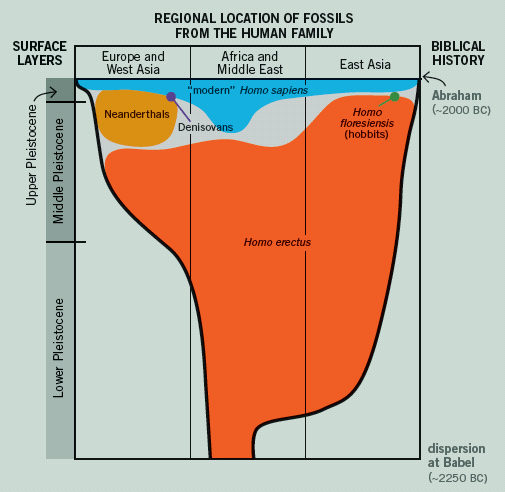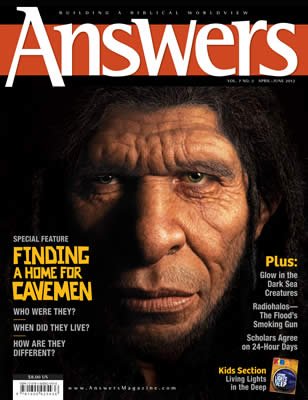When Did Cavemen Live?
Finding a Home for Cavemen
The Bible recounts the sweep of human history, from the first man, Adam, to Noah, Abraham, Moses, and finally, Jesus Christ. In this panoply of amazing people, places, and events, where do the fossils and artifacts of “early man” belong?
When a couple of German quarry workers stumbled upon a Neanderthal fossil in a cave in the Neander Valley, back in 1856, paleoanthropology (the study of early humans) vaulted into the limelight. And popular interest has never died down.
As the findings of early human fossils and artifacts continue to pile up, the story has become even more interesting and complicated. Remains from hundreds of different individuals have been discovered so far. They range from the southern tip of Africa to Russia’s frigid Siberian mountains and the tropical islands of Indonesia.
The chart (below) shows the sequence that these human remains are found in today’s post-Flood surface layers, and the following pages have maps showing where these remains occur.1 Most paleoanthropology books show charts and maps similar to these. So how do creationists explain the timing and location of these early human remains from a biblical perspective?
Fossil Record of the Human Family

The earliest human remains are found in Ice Age deposits near Babel. By the middle of the Ice Age, however, human remains were scattered over three continents. New variations eventually appeared in different regions, such as Neanderthals in Europe. But by the end of the Ice Age, most of these variations disappeared. It is only at this late stage in the Ice Age that we find human remains in the Americas.
Time of “Cavemen”
Let’s first consider the timetable of these early fossils. The Bible gives invaluable clues.
First Cavemen After Babel
First, we know that the entire human race consisted of eight individuals at the end of the Flood, around 2350 BC. This was one “family,” but four were women who married into Noah’s line. So the maximum number of family lines who brought their genes onto the Ark was five (four potentially unrelated women, and one line of men).
Furthermore, we know that all humans who settled the planet after the Flood were descended from Noah’s three sons: “These three were the sons of Noah, and from these the whole earth was populated” (Genesis 9:19). According to Genesis 11, they had many sons and daughters, including Canaan, whose descendants eventually founded the Canaanite cities where Abraham later sojourned.
Noah’s growing family eventually moved en masse to the plain of Shinar (in modern Iraq), where they decided to build a city.
No cavemen yet.
The dispersion from this first city, Babel, sets the oldest time limit for the humans whose remains occasionally appear in caves. The Bible does not give a specific date for this event; but it does say that the earth was “divided” in the days of Peleg, five generations after Noah; and presumably this is a reference to Babel. If the dispersion from Babel occurred at Peleg’s birth, the earliest date would be one century after the Flood, around 2250 BC according to the Masoretic text.2
Last Cavemen Before Abraham
The dispersion from Babel explains when humans first spread over the continents. But at what point in biblical history did the men and women known as Neanderthals and their kin disappear?
Solving that mystery is a little more complicated.
An important clue is that all these humans are found in surface deposits associated with the post-Flood Ice Age (conventionally labeled as the Pleistocene). Their bones appear buried alongside extinct Ice Age animals, such as mammoths and stegodons.
The book of Genesis does not specifically mention this relatively brief era of worldwide climate change, but glaciers left grim reminders of their destructive power throughout northern Europe, Asia, and North America, as well as the mountainous highlands of Africa, South America, and South Asia.
The Ice Age began after the Flood and eventually came to an end. Again, the Bible provides us with important clues to establish rough dates. By Abraham’s day, around 2000 BC, cities had cropped up throughout the Middle East. None of the Neanderthals and their Ice Age cousins are found associated with any of these cities. Nor do we find any remains of Ice Age animals associated with these settlements.
In fact, any charcoal from Ice Age deposits consistently dates earlier than anything from the cities.3 For instance, ten Neanderthals were found in an Iraqi cave north of Babel (Shanidar Cave), dating before any city in this region. Similarly, Neanderthal fossils are found in caves of Israel, such as Skuhl Cave at Mount Carmel, but the remains date before the earliest Canaanite cities, such as Jericho.
One basic relative sequence in the successive post-Flood surface layers is not disputed: the Ice Age preceded the warmer period we are in today. Since the remains in all known cities postdate the Ice Age and have no Ice Age remains, it appears the effects of the Ice Age had waned before the establishment of the cities where Abraham sojourned.
Location of Human Fossils
The Bible gives the timeframe for the spread of early humans. But what about the location of their remains?
Genesis does not give many details about the geography immediately after Babel, but it is not hard to fill in some of the gaps. At the height of the Ice Age, so much water was bound up in ice that the ocean level plummeted 330 feet (100 m) below today’s level. The earth’s landscape was very different from today. The best spots for raising a family were much different than they are now!
Compounding the problem of establishing permanent settlements was the shifting climate, heavy rains, and unstable earth in the years after the global Flood cataclysm. The geology from this era indicates that massive earthquakes and volcanic eruptions still rocked parts of the earth, dwarfing any local catastrophes we observe today.
It is easy to imagine why the early human populations kept migrating.
As Noah’s children overspread the earth, they needed temporary shelter. We can see why they might have sometimes needed to stay in caves for convenience.4 Caves would also be an excellent place for them to preserve the bodies of their loved ones.
Early Fossils Near Babel
Yet the families survived, as we can see in the record of Genesis 11. So we would not expect to find a trail of bodies from Babel to their new destinations. Instead, we would expect to find humans and artifacts suddenly cropping up at destinations all around Babel.
And that’s what we find in the fossil record. Except for a few stone tools and some footprints left in volcanic ash in East Africa, we do not find human remains in any post-Flood deposits until suddenly they appear in multiple regions in the same relative level of the Lower Pleistocene (see map 1, below).
The Spread of Humans from Babel: Map 1 and Map 2

Map 1: The earliest human fossils are found in regions around Babel.
They are similar in appearance, often labeled Homo erectus.
Map 2: By the middle of the Ice Age, families were
scattered across Asia, Africa, and Europe.
Fossils and stone tools in East Africa and Central Asia have been dated from the same general time period. In fact, these fossils are so close in time that experts debate which came first. Specifically, human fossils were discovered in the mountainous region north of Babel (the Republic of Georgia) and appear to be as old as anything found in East Africa.
These human fossils—and their stone tools—are strikingly similar everywhere they are found in the Lower and Middle Pleistocene layers5 (see map 2). These people had large brow ridges, small chins, and receding foreheads. Although experts sometimes give the fossils different names in different regions, they recognize the similarities and agree they could be called by one name.6 (They usually call them Homo erectus.)
Later Variation Among Fossils
In upper deposits (Upper Pleistocene), a fascinating variety appears among Noah’s descendants. These human remains are located in a much greater range of places at the very farthest reaches of Europe, South Africa, and East Asia (see map 3).
The fossils also show a great variety of physical features. The Bible hints that God created the human body capable of a wider variety of forms than we see today. The giant Goliath, for instance, stood over 9 feet (3 m) tall. But these Ice Age deposits show us still other possibilities in God’s design, such as the 3-foot-tall (1 m) “hobbit” (Homo floresiensis) humans found on the Indonesian island of Flores.
The Spread of Humans from Babel: Map 3 and Map 4

Map 3: Interesting variations appeared later in the Ice Age, including
Neanderthals, “hobbits,” and the little-known Denisovans.
Map 4: By the end of the Ice Age, people with high foreheads and
protruding chins filled the globe, including the Americas.
While it is difficult to distinguish family resemblances just from bones, some seem pretty clear among the later Ice Age fossils of each region. In European sites we find the first human families with Neanderthal features, while in Africa we find another family variation with high foreheads and protruding chins (like us today). Meanwhile in Asia, the fossils generally have the pronounced brow ridges and other features associated with the earlier Homo erectus fossils.
Neanderthals’ compact body shape would have made them well suited for cold weather, similar to the Inuits (sometimes called Eskimos) of North America’s Arctic regions today. As hunting ranges in Europe were covered in ice, it would have made sense for the Neanderthals to move south into the Middle East, even if it meant displacing other people there. That might explain why Neanderthals are found buried at certain soil levels in caves in Israel, with other people found in layers before and after them.
Interestingly, the human remains at the end the Ice Age display only one variation of the human physique: people with protruding chins and high foreheads like ours. In Europe, these people are known as Cro-Magnon, but the difference between them and us is inconsequential.
End of the Ice Age
Not a single Neanderthal, Homo erectus, or hobbit fossil has ever been found in the topmost layers. They only appear with Ice Age plants and animals, which are now extinct.
The last Neanderthal fossils are found in locations in southern France and Gibraltar, while Cro-Magnons appear in the more recent layers, above them. The same pattern is repeated elsewhere (see map 4). Apparently, Neanderthals and their cousins died off about the same time that the Ice Age ended.
Genesis then picks up the human narrative with Abraham. Even in his day, caves still were in use. Genesis mentions that Lot fled to a cave to avoid God’s judgment (Genesis 19:30), and Abraham bought a cave to bury his dead (Genesis 23:8–20). Their function may give us a clue about the role of caves among post-Babel migrants. Caves were temporary hiding places or convenient places to preserve the bodies of loved ones, but they were not normal living spaces.
By Job’s day, cave dwellers had earned a bad reputation. “Civilized” folk did not live in caves. “Cavemen” tended to be oppressed people who had lost their homes (Job 24:4–8) or bandits and loners who had left civilized society and behaved like wild animals (Job 30:3–8).
While we still have a lot to explain and understand, the overall picture is clear. The two hundred years or so after Babel (over 300 years after the Flood) was a chaotic transition in world history. The Bible gives us only a brief glimpse into that time and place, but the fossils hint at a grim tale.
Thankfully the human story does not end there. Indeed, the Bible passes over this transitional period with only a brief mention, and then picks up with God’s promise to Abraham—to bless all peoples through His promised seed, the Savior Jesus Christ. And that promise includes every sinner and outcast—ultimately every one of us.
Answers Magazine
April – June 2012
Now’s your chance to answer every question you ever had about cavemen! This issue is chock full of the latest information about Neanderthals, Homo erectus, “the Hobbit,” and other media stars. Were they like us? How did they die? Also learn about the wonders of the sun, creatures that glow in the dark, and the reason all Hebrew scholars agree that Genesis 1 says creation was six literal 24-hour days!
Browse IssueFootnotes
- The Flood deposited all the fossil-bearing sediment layers that hardened into rock strata as the waters receded. Caves and rock shelters were then produced in these rock strata by physical and chemical erosion as the last waters receded and as the earth’s surface continued to dry out with the onset of the Ice Age. Successive surface sediment deposits then accumulated across the landscape, including on the floors of those caves and shelters. Investigators today dig down into these surface deposits and find remains of humans and the artifacts they used. So when surface and cave floor deposits are dated, they are named in a relative sense, according to the depths of each successive layer. Hence the terms such as lower, middle, and upper Pleistocene (= Ice Age). The maps and charts like the ones in this article are based on the most reliable findings and on such relative dating.
- The Bible does not explicitly say when Babel occurred during Peleg’s life. Theoretically it could have fallen anywhere within the first two to four centuries after the Flood. See “Egypt or Babel: Which Came First?” Answers, April–June 2008, pp. 30–33.
- Where charcoal, seeds, and other once-living remains (even wooden artifacts) have been radiocarbon (carbon-14) dated, the results support the relative dating sequence of these surface layers, but they yield ages of only thousands of years (not millions). For a full explanation of the value and limitations of radiocarbon dating, see the three-part series of articles in Answers magazine (Oct.–Dec. 2010 to Apr.–June 2011 issues).
- It appears that few, if any, early humans spent prolonged periods of time in any caves. If small populations had lived there for decades or centuries, we would expect to find lots of artifacts (trash). In addition, their fires would have baked the walls, and they would have brought moisture, soot, and vermin into the caves, encouraging mold and wreaking havoc on the interiors. Instead, we find only a few bodies and a few hearths and artifacts. Most caves are “clean” and beautifully preserved.
- We do not find any remains of these early post-Babel people in North and South America, suggesting humanity’s arrival in the Americas was much later, near the end of the Ice Age.
- Bernard Wood and Nicholas Lonergan, “The Hominin Fossil Record: Taxa, Grades, and Clades,” Journal of Anatomy 212 (2008): 373.”
Recommended Resources

Answers in Genesis is an apologetics ministry, dedicated to helping Christians defend their faith and proclaim the good news of Jesus Christ.
- Customer Service 800.778.3390
- Available Monday–Friday | 9 AM–5 PM ET
- © 2025 Answers in Genesis





